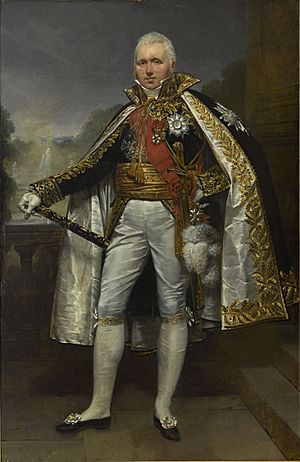Claude Victor-Perrin, duc de Bellune facts for kids
Quick facts for kids
Marshal of the Empire
Claude-Victor Perrin
Duke of Belluno
|
|
|---|---|

Portrait by Antoine-Jean Gros
|
|
| Born | 7 December 1764 Lamarche, France |
| Died | 1 March 1841 (aged 76) Paris, France |
| Buried |
Père Lachaise Cemetery, Paris, France
|
| Allegiance | |
| Rank | Marshal of the Empire |
| Battles/wars | French Revolutionary Wars, Napoleonic Wars |
| Awards | Grand Cross of the Legion of Honour |
Claude-Victor Perrin, also known as the Duke of Belluno, was a famous French military leader. He fought in two big conflicts: the French Revolutionary Wars and the Napoleonic Wars. In 1807, Emperor Napoleon I made him a Marshal of the Empire, which was a very high military rank.
Contents
Life of Claude-Victor Perrin
Claude-Victor Perrin was born in Lamarche, France, on December 7, 1764. When he was 17, he joined the army as a drummer in an artillery regiment. After serving for ten years, he left the army.
In 1791, he married Jeanne Josephine Muguet. Later, in 1803, he married Julie Vosch van Avesaat.
Fighting in the French Revolutionary Wars
In 1792, Victor joined the National Guard and then other army groups. He quickly became a leader.
Early Battles and Promotions
Victor fought with the Army of Italy and showed great bravery. During the Siege of Toulon in 1793, he helped capture important forts. He was even seriously wounded during this time. Because of his courage, he was promoted to brigade general.
From 1794 to 1795, Victor fought in the War of the Pyrenees. He helped in sieges like Collioure and Roses. He also fought well at the Battle of the Black Mountain.
Campaigns with Napoleon
Victor continued to serve in Italy under General Napoleon Bonaparte. He took part in many battles, including Dego and Rovereto. In 1797, he was promoted to general of division. He captured the city of Ancona and a lot of weapons.
Later, Victor returned to the Army of Italy in 1799. He fought in battles like Trebbia and Genola. In 1800, he led his division at Montebello and played a key role at the Battle of Marengo.
After these wars, Victor was put in charge of the Army of Batavia. He was also planned to lead an expedition to Louisiana, but this trip was canceled. In 1805, he became an ambassador to Denmark.
Fighting in the Napoleonic Wars
When France went to war with Prussia, Victor became a chief of staff. He fought in battles like Saalfeld and Jena in 1806.
Becoming a Marshal
In 1807, Victor helped besiege cities like Kolberg and Danzig. He was briefly captured but was quickly exchanged for a Prussian general.
He then took command of the 1st Army Corps. At the Battle of Friedland on June 14, 1807, Victor's troops broke through the Russian army. For this great victory, Napoleon made him a Marshal of the Empire on July 13. This was a huge honor.
Battles in Spain
After becoming a Marshal, Victor was made Duke of Belluno in 1808. He then went to fight in the Peninsular War in Spain. He won battles against the Spanish, like the Battle of Espinosa and Uclès.
As commander of the 1st Army Corps, he also fought at Talavera and Medellín. At Medellín, he defeated a large Spanish army. He later tried to capture Cádiz but could not, as the city was supplied by sea.
Russian Campaign and Later Wars
In 1812, Victor was called back to France for the French invasion of Russia. He led 30,000 men and protected the army's supply lines. His most important job was protecting the retreating French army at the Berezina River.
In 1813, he fought in many more battles, including Dresden, Leipzig, and Hanau.
During the French campaign of 1814, Victor continued to fight bravely alongside Napoleon. He took part in battles like Brienne and La Rothière. He also defeated a Russian corps at the Battle of Mormant.
Victor was wounded at the Battle of Craonne in March 1814. This injury made him use crutches for several months.
Life After Napoleon
After Napoleon was defeated in April 1814, Victor supported the return of the House of Bourbon kings. He was given new commands and honors by King Louis XVIII.
When Napoleon briefly returned from exile in 1815, Victor stayed loyal to the king. After Napoleon's final defeat at Battle of Waterloo, Victor returned to Paris with the king. He was made a peer of France and a major-general.
Victor was appointed Minister of War in 1821 and held this job for two years. He helped prepare for the 1823 French intervention in Spain.
After the July Revolution in 1830, Victor refused to support the new king, Louis Philippe. He left public life and retired. He died in Paris on March 1, 1841, and was buried at the Père-Lachaise Cemetery.
Personal Life and Family
Victor had four children with his first wife, Jeanne-Josephine Muguet:
- Victorine (1792–1822)
- Charles (1795–1827)
- Napoleon-Victor (1796–1853)
- Eugene (1799–1852)
With his second wife, Julie Vosch van Avesaet, he had one daughter:
- Stephanie-Josephine (1805–1832)
Military Skills
Claude-Victor Perrin was a skilled military leader. He was very good at organizing his troops and planning battles. In Spain, he managed to defeat entire armies. He also showed he could learn new strategies, like using "reverse slope defenses" at the Berezina River. While he was sometimes careful in his overall plans, he was always ready to try new ideas in warfare.
Images for kids
See also
 In Spanish: Claude-Victor Perrin para niños
In Spanish: Claude-Victor Perrin para niños


